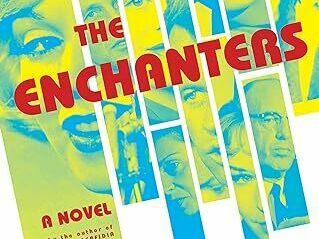Section Branding
Header Content
In 'The Enchanters' James Ellroy brings Freddy Otash into 1960s L.A.
Primary Content
The Demon Dog is back. So is Freddy Otash, and he's trying to dig up the most important dirt of his infamous career.
James Ellroy's The Enchanters is classic Ellroy: a filthy, boozy, fast-paced, violent romp through the history and important figures of early 1960s Los Angeles, all told in Otash's frantic voice. The Enchanters marks the return of Freddy O, a disgraced ex-LAPD cop and Confidential magazine dirt digger turned shifty private investigator and Hollywood fixer. Readers first met Otash in Widespread Panic, Ellroy's 2021 novel about the seedy underbelly of 1950s L.A. At the time, I called it the most Ellroy novel he had ever written. The Enchanters is on par with it.
It's the later summer of 1962 and L.A. is feeling the heat in many ways. Freddy Otash is working his private eye gig, collecting information, spying on people, and making money. Then Jimmy Hoffa offers Otash a new gig. He wants to know everything Marilyn Monroe is up to. For almost four months, Freddy and his gang tail Monroe. They tap her phones and bug her house. They listen in on all her phone calls and look at her from observation posts they rent for that sole purpose. They infiltrate the movie she's working on. Freddy follows her in his car to every pill party, meeting, and secret rendezvous. He needs to know everything Monroe says and does, and that includes her relationships with John F. Kennedy and his brother Robert.
Then Monroe dies from what looks like an accidental overdose and everything changes.
The Monroe job went deep, but the new assignment goes much deeper and all the way to the White House. After following the huge star for months and ending up with more questions than answers, Otash suddenly finds himself once again on the side of the law, trying to undo some of what he did, hiding important information to protect others, and rubbing elbows with local law enforcement as well as Jack and Bobby Kennedy. Everyone has an agenda, and they all want something from Otash. What follows is a wild romp through a multiplicity of cultural and political spheres that perfectly encapsulates the dirty, ruthless L.A. full of secrets that Otash helped to create.
The Enchanters is so complex, multilayered, and full of characters that there is a four-page list of characters at the end as well as a glossary of police and criminal terms, codes, and abbreviations. However, Ellroy keeps things moving at breakneck speed at all times, which is a fantastic feat considering this is a 448-page novel that delves deep into a plethora of scenes and seamlessly mixes fact and fiction. The trick to it is Ellroy's incomparable style; fast, punchy, telegrammatic prose that demands to be read quickly and that flows like an enraged river.
While there are many characters in this novel, Otash is, once again, the star at its core. He's always up to something, and almost always manages to come up with a solution to things despite his penchant for booze and dexies. He has an almost photographic memory, is a true breaking and entering artist, and doesn't mind getting his hands dirty. In many ways, Otash, a real figure that has morphed into a legend in Ellroy's fictionalized treatment of two of L.A.'s most explosive decades, is the perfect narrator not only for this novel and its predecessor — he is easily one of the most vibrant and memorable narrators of that era in fiction.
If Otash is the star here, then Marilyn Monroe is the perfect co-star, even after death. She's a big presence that's never truly there. She has strange dealings with a Mexican man and might be moving drugs. She keeps calling the White House and Justice Department switchboards and claims to have dirt on the "K boys." She has a lot of money under her mattress. She's drinking vodka, popping pills, and driving erratically all over L.A. She is a burning star, a rogue force of nature that feeds on the zeitgeist while helping to shape it, an explosion waiting to happen that finally delivers a tragic end. As Otash follows her, her legend changes and grows while also revealing her very human side and shining a light on what her life was truly like before her untimely death: "I peeped her trailer three days running. I observed the Marilyn Quadrafecta: pop pills/booze/barf/pass out."
Marilyn Monroe's death has achieved myth status, and Ellroy's take on it is at once a superb crime novel about the city he's always written about, a love letter to a very different time, and a narrative that ensures the Freddy Otash novels will be mentioned along the novels in The L.A. Quartet and the Underworld U.S.A. Trilogy as some of Ellroy's best work.
Gabino Iglesias is an author, book reviewer and professor living in Austin, Texas. Find him on Twitter at @Gabino_Iglesias.
Copyright 2023 NPR. To see more, visit https://www.npr.org.

